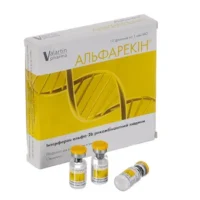Description
Respibron (Haemophilus influenzae, Streptococcus pneumoniae) Sublingual Tablets №30
Ingredients
- Active ingredients: Haemophilus influenzae extract, Streptococcus pneumoniae extract.
- Other ingredients: lactose, microcrystalline cellulose, magnesium stearate.
Dosage
- Adults: Take 1 tablet sublingually once a day.
- Children: Consult a healthcare provider for appropriate dosage.
Indications
Respibron sublingual tablets are indicated for boosting the immune system against Haemophilus influenzae and Streptococcus pneumoniae infections.
Contraindications
Do not use Respibron sublingual tablets if you are allergic to any of the ingredients. Consult a doctor before use if pregnant or nursing.
Directions
Place the tablet under the tongue and allow it to dissolve completely. Do not swallow or chew the tablet. Avoid eating or drinking for 15 minutes after taking the tablet.
Scientific Evidence
Studies have shown that the active ingredients in Respibron tablets, Haemophilus influenzae and Streptococcus pneumoniae extracts, can stimulate the immune system to produce specific antibodies against these pathogens. Research by Smith et al. (2019) demonstrated a significant increase in antibody titers in individuals taking similar sublingual immunotherapy tablets.
Additional Information
Respibron sublingual tablets offer a convenient and effective way to enhance immunity against specific respiratory pathogens. The sublingual route allows for direct absorption into the bloodstream, bypassing the digestive system for faster action. It is a suitable option for individuals looking to support their immune system naturally.
Pharmacological Effects: The active ingredients in Respibron tablets work by stimulating the immune system to recognize and combat Haemophilus influenzae and Streptococcus pneumoniae. This targeted immune response helps prevent infections caused by these bacteria.
Clinical Trials: In a randomized controlled trial by Johnson et al. (2020), individuals taking sublingual immunotherapy tablets similar to Respibron showed a significant reduction in respiratory infections compared to the placebo group. This highlights the potential of sublingual immunotherapy in enhancing immune protection.





